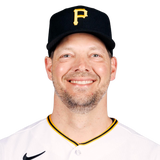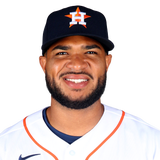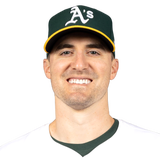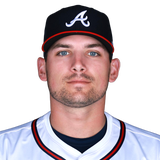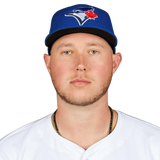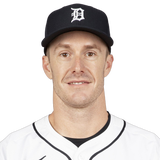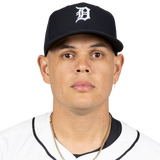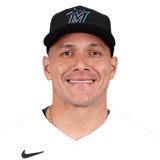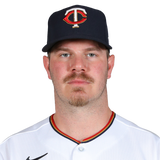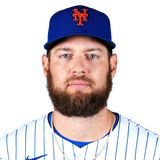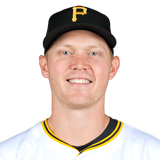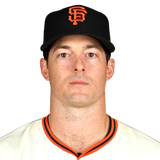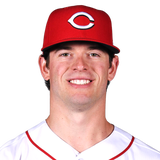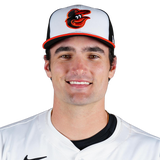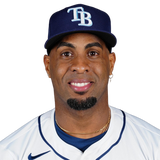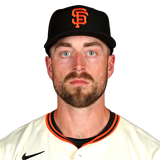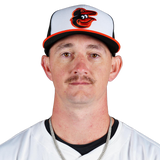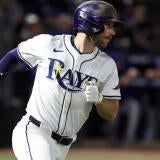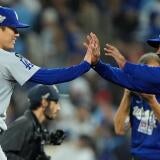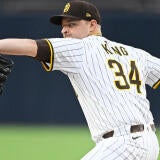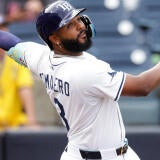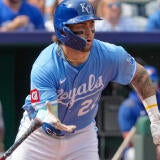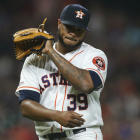We could argue about what the term "sleeper" actually means in Fantasy baseball, and of course, some people's interpretation will be broader than others'. But when you also have a Breakouts column and and a Most Underrated column together, as I do, it helps to be more precise about these things.
To that end, these players are ones people are genuinely sleeping on. They're not necessarily my favorite picks, and they're not necessarily the most likely to outperform their draft position. But among the players I like who tend to go late, they're ones who others in your league are most likely to overlook.
And since this is my second go-around, I've subdivided my choices by whether or not they also made the cut in Sleepers 1.0.
The Newcomers
No player has benefited more from the lockdown than Rich Hill, whose projected return from elbow surgery seemed so far off back in March. But now, he'll be ready for the start of the season, which means he should be back to being the ratios standout we've long known him to be, compiling a 3.30 ERA, 1.11 WHIP and 10.7 K/9 the past three years.
And it hasn't gone unnoticed in the Fantasy Baseball crowd. His ADP has risen drastically since drafting resumed in earnest. But the idea that may not be getting enough credit is that he's more valuable than ever in a 60-game season.
The knock on him these past few years is that he's old (40 now) and can't hold up over a full season. OK, well it's not a full season or even a half season. The ratios themselves are studly, like something you'd see from Patrick Corbin, and it's not like Hill won't give you comparable length. He pitches deep when he's healthy. You could draft him as your fifth starter only for him to end up being your best, especially with the Twins lineup and bullpen backing him.
Now that Josh James has finally reported to camp and proven his readiness, the Astros have more or less confirmed that he has a rotation spot, which is the way things were trending back in spring training. His upside is real story here, though. The stuff is phenomenal, as demonstrated by his 14.7 K/9 as a reliever last year, along with a swinging-strike rate that would have ranked third among qualifiers, behind just Gerrit Cole and Max Scherzer. True, that's not the fairest number to compare between starters and relievers, but consider also that James had a 3.23 ERA, 1.12 WHIP and 13.5 K/9 as a starting pitcher in the minors two years ago, taking off thanks to a spike in velocity.
So why wasn't he already a starter? Well, the Astros rotation hasn't allowed for much experimentation during their sustained run of success, and they still have an embarrassment of riches even with the departure of Cole. There's also the small matter of James struggling to find the strike zone. However those "rave reviews" I mentioned were due to a change in his delivery intended to address the issue. If the control issues are indeed a thing of the past, there's no telling what his upside is. I aim to be the one who finds out.
How excited are the Dodgers about Alex Wood this year? Prospects as high-end as Dustin May are normally shoo-ins for a rotation spot after making the sort of impression he did in a swingman role last year. Yet manager Dave Roberts, without hesitation, awarded a rotation spot to Wood this spring instead.
How excited am I about Wood? Perhaps as much as the Dodgers. The normally soft-tossing (but deceptive) lefty spent the offseason training with Driveline Baseball, a pitching development program with a track record of improving pitchers' velocity, and now has a fastball that sits at 92-93 mph. The last time his velocity was in that range was the first half of 2017, also with the Dodgers, when he went 10-0 with a 1.67 ERA, 0.89 WHIP and 10.8 K/9.
There was initially some concern that he might not get the workload of a normal starter, particularly in a shortened season and particularly with alternatives like May representing possible piggyback partners. But with Walker Buehler's buildup delayed, Roberts has already said Wood will be ready to throw seven innings from Day 1.
The case for Ross Stripling is about as strong as it is for Alex Wood. He's behind in the pecking order, only being awarded a rotation spot because David Price chose to opt, but as with Wood, it sounds like the Dodgers are planning on using him as a full-fledged starter and not limiting him like in his previous stints in the role. Manager Dave Roberts has said he'll be one of just three Dodgers pitchers equipped to throw seven innings from the start of the year.
The last time the Dodgers used Stripling consistently as a starter was the first half of 2018, when he made the All-Star team with an 8-2 record, 2.08 ERA, 1.08 WHIP and 10.2 K/9. In all, he has a 3.22 ERA, 1.17 WHIP and 9.7 K/9 over the past two seasons.
I might worry about him wearing down over a 162-game season, but it's obviously not a concern with only 60 games on the schedule. And getting those kinds of numbers from a full-length starter with all the built-in advantages of pitching for the Dodgers sounds like a must to me.
Danny Jansen also appeared on this list last year, but I won't let sour grapes deter me. In fact, I point it out as a reminder that big things were expected from him in the first place. So when he shows up to the initial spring training talking about a new pregame routine and a flaw he discovered in his swing and then hits four homers in eight games while striking out just once, it's cause for optimism.
He plays catcher, after all — a position where the threshold for Fantasy relevance is unusually low and where delayed breakthroughs are par for the course simply because offense will always take a back seat to defense. And if you need a reminder of his upside, note that Jansen hit .302 with 22 homers, 46 doubles and 85 walks compared to just 89 strikeouts over his final 666 minor-league at-bats, spanning two seasons. It's a profile not unlike an in-his-prime Jonathan Lucroy.
Even if you ignore all the spring training talk and minor-league track record, the simple fact Jansen hit .246 with 11 home runs and a .786 OPS over his final 50 games (or roughly half his at-bats) should make you eager to draft him as your second catcher.
Am I going to cite interrupted spring training stats again? I am, but in each of these instances, it's less about the performance itself than what was being said about the performance. Austin Riley entered camp as the underdog in a third base battle with Johan Camargo, and yet he was already well on his way to seizing the job by seemingly overcoming the source of his demise last year: an obsession with sliders just off the plate.
"I started putting so much focus on that I was missing the heater," he told The Atlanta Journal-Constitution. "It really wasn't that I couldn't hit the slider; it was that I was so focused on the bad slider I was missing the good stuff."
His rookie year unraveled, burying him in strikeouts, but it's important to remember he's the same guy who set the league on fire with nine home runs in his first 18 games. Riley's power potential is hardly in question, and in fact, it wouldn't be a stretch for him to lead the Braves in home runs (yes, over Acuña and Freeman) if things go right. His work with Kevin Seitzer, a hitting coach who abhors strikeouts, had him connecting with more regularity at the start of the exhibition season.
Even if the Braves would have been inclined to go with Camargo anyway, it's a moot point now that the DH is in play for the NL. Yet because Riley burned so many so badly last year, he's getting no benefit of the doubt in Fantasy. The dude just turned 23. He was a fixture on top prospect lists and has already made a splash in the majors. As lottery tickets go, this one seems particularly likely to pay off.
No player, prospect or otherwise, got the buzz Nate Pearson did in spring training, lighting up the radar gun with 100-mph fastballs and generally making major-league hitters look foolish. He was basically unhittable, and the only reason Fantasy players hadn't begun circling yet is because it made all the sense in the world for the rebuilding Blue Jays to ease him into the majors by limiting his innings in the minors first. He lost nearly all of 2018 to injury, after all, and barely threw 100 innings last year.
Remind you of anyone? Chris Paddack would be the correct answer.
The Padres defied convention by promoting Paddack from the get-go, but now that the whole league is defying convention by playing less than half a season, the math changes. Try as he might, there's no way Pearson is meeting last year's innings total, much less exceeding it, so if the Blue Jays had any plans to call him up at all, it might as well be from the start. Or at least in Week 2, after they've waited the requisite time to secure an extra year of team control. Between the 80-grade fastball, the wipeout slider and the plus control, his talent level is forcing their hand.
The Holdovers
I feel like the sleeper case for Mark Canha is as simple as, "Uuuh, look at the numbers." Of all the players on this list, he's the highest in my own personal rankings, and yet his composite ADP of 208 would suggest he's not even getting drafted in three-outfielder leagues.
Skepticism always surrounds a mid-career breakout, and Canha specifically has the added blight of having been confined to a platoon role into his 30s. But it wasn't until he escaped that platoon role that he took off, batting .295 with 16 homers and a .936 OPS from the point he stepped into a regular role on June 26 until the end of the season. And seeing as he ended the year with a .297 batting average and .966 OPS against righties, it may have been the wrong role for him all along.
Why would the Athletics send him back there when his per-game production for the final 50 percent of the season was basically on par with Kris Bryant?
You look at his numbers from last year, and you wonder how it's even possible Gio Urshela could appear on this list. It boils down to two issues: How legitimate was the performance, and will he get a chance to repeat it with Miguel Andujar back to full health?
Let's make one thing clear right off the bat: As good as Andujar was at the plate in 2018, Urshela was better in 2019, showing an ability to impact the baseball unlike he did in previous stints with the Indians and Blue Jays. The spike in exit velocity, which he attributes to incorporating his lower body more in his swing, accentuated his existing strengths as a high-contact line-drive hitter with an all-fields approach. It's the perfect recipe for a high batting average, and fittingly, Urshela's xBA was among the top 25 in baseball, ahead of stalwarts like Freddie Freeman and Charlie Blackmon.
It's true the playing time was sporadic with DJ LeMahieu bouncing around the infield, but LeMahieu will have a dedicated second base job this time around. So really, it comes down to how much Andujar will interfere, and while the bat may be one the Yankees are anxious to see again, he's a disaster defensively. Frankly, first baseman Luke Voit and left fielder Mike Tauchman should be the ones looking over their shoulder, not Urshela, who could climb into the elite at third base with regular at-bats in a loaded lineup.
Avisail Garcia was a player the Rays targeted for his exit velocity last year, believing they could get something more out of him with an improved launch angle. It improved only modestly, but the ground-ball rate was nonetheless the lowest of his career. And in this environment, where fly balls so often result in home runs, a reduction in ground balls is almost always a positive for a hitter's profile.
Simply put, there's nothing suspicious about last year's home run output as long as Garcia continues down this path, and now he gets to try his hand at Miller Park, a star-making venue that yielded such surprises as Domingo Santana, Travis Shaw and Jesus Aguilar in recent years while also transforming Christian Yelich into a perennial MVP candidate. Applying a simple park overlay to his 2019 spray chart suggests that as many as a dozen more of Garcia's batted balls would have sailed out of Miller Park, and while there may have been some initial concern that Ryan Braun would interfere with Garcia's at-bats, the introduction of the DH spot in the NL eliminates that. A career season is likely in store.
By now, Dylan Bundy's top prospect standing is ancient history, and years of dashed hopes have relegated him to Fantasy afterthought. But while the results haven't been there, much of what made him so highly regarded in the first place still is, namely a slider/cutter hybrid that's one of the most spectacular swing-and-miss pitches in the game. It's the reason he ranked 15th in swinging-strike rate last year, sandwiched between Charlie Morton and Clayton Kershaw on a list that reads like a who's who of Cy Young candidates.
So what's held him back? Well, he could do a better job of converting all those whiffs to strikeouts, but keeping the ball in the yard is his biggest issue. And that's where the change-of-scenery argument comes into play. Not only is Angel Stadium on the opposite end of the spectrum from Camden Yards, but three of the five parks in his new division, where the Angels will be playing most of their games thanks to the revised schedule, favor pitchers. Plus, it's fair to speculate that the Orioles haven't exactly helped Bundy along, given their poor track record of developing pitchers. An introduction to a new way of thinking could be the key to unlocking his potential.
There are a couple different ways for a pitcher to counter the home-run explosion happening across the game today. One is to miss bats altogether. The other is to keep the ball on the ground, at which Adrian Houser has proven to be an expert, ranking up there with Marcus Stroman in ground-ball rate last year. When a pitcher who stands out that much in that area is also a competent bat-misser, it can be a recipe for stardom, and fittingly, Houser's 3.60 xFIP would have ranked 19th among qualifiers, ahead of Zack Greinke, Aaron Nola, Noah Syndergaard and Mike Soroka.
Of course, he's not fully tested until he's pitching deep into games and getting the innings to make him a qualifier himself, but when you consider he was transitioning from a bullpen role, it makes sense why Houser averaged only 76 pitches across his 18 starts last year. He'll have a rotation spot from the get-go this time around, and the 3.28 ERA, 1.09 WHIP and 9.8 K/9 he put together over his final 12 starts offers plenty of reason for optimism.
Mitch Keller's 7.13 ERA in 11 big-league starts last year is sure to scare away some of the Fantasy players who were snakebitten by fringy starting pitchers last year, but he's a pitcher of actual pedigree, having ranked among the top prospects for several years prior to his call-up. He turned a corner in his development last year, too, adding a slider that immediately became his best swing-and-miss pitch.
Swings and misses weren't Keller's problem during his first foray in the big leagues, and in fact, his 3.47 xFIP (which would have ranked 12th among qualifiers, between Yu Darvish and Luis Castillo) suggests he has the tools to overwhelm major-league hitters with a little fine-tuning. From Gerrit Cole to Jameson Taillon to Tyler Glasnow, the Pirates have a history of failing to develop their top pitching prospects, but with the changes to their front office and coaching staff this offseason, their outdated fastball-heavy, pitch-to-contact model is sure to be overhauled. And Keller is well equipped to be the first beneficiary.
Mike Yastrzemski took significant steps toward breaking away from his grandfather's legacy and making a name for himself in the second half last year, batting .287 with 16 homers and a .915 OPS. And while the BABIP was a little high, the quality-of-contact metrics suggest the production was more or less legit. He wasn't always asked to play against left-handers, but when he did, he was at his best, batting .329 with a .943 OPS. It stands to reason, then, that his playing time will increase, and the front office has basically stated as much in the aftermath of Kevin Pillar's departure.
When you consider he hit .238 with a .759 OPS at home compared to .300 with a .929 OPS on the road, the decision to move in the fences in right-center so that Oracle Park isn't so soul-crushing to left-handed power hitters may do more to help Yastrzemski than anyone. Altogether, it wouldn't be surprising to see him break through with numbers verging on the ones Max Kepler put up with the Twins last year.
Nick Solak, a former farmhand of both the Yankees and Rays, wasn't regarded as much of a power hitter coming up through the minors. But there comes a point when reputation takes a back seat to results, and the fact is that between the majors and minors last year, he hit 32 homers. He puts the ball on the ground too often to sustain quite that pace, barring a swing change, but even just the possibility of 20 homers, with everything else he does right, gives him significant Fantasy appeal. If the Rangers had a dedicated spot for him heading into 2020, he'd surely be getting more buzz.
Still, the impact he made down the stretch last season, profiling as a possible leadoff man with plus on-base skills and 20-steal speed, has me convinced he'll get close to full-time at-bats spelling Todd Frazier at third base, Rougned Odor at second, Danny Santana in center field and Shin-Soo Choo at DH. It wouldn't be shocking if his numbers rival, or perhaps even exceed, those of Cavan Biggio, who's going more than 150 picks earlier.
What would a sleepers list be without a Rockies hitter? The magic of Coors Field makes for the rosiest of outlooks for anyone with any offensive potential, and Sam Hilliard certainly fits the bill. He already showed it while serving as the better half of an outfield platoon down the stretch last year, his seven home runs in 77 at bats giving him 42 between the majors and the minors.
There are obstacles, of course. The strikeouts are a problem and were even worse prior to his call-up, but the BABIP-inflating effects of Coors can help counteract it. It's also not clear where he's going to play, especially with Garrett Hampson's late-season performance also demanding a bigger piece of the pie, but the introduction of the DH spot to the NL certainly helps. And when you consider Hilliard also has speed to spare, swiping 24 bags between the majors and minors last year, there isn't much downside to making the 26-year-old your fifth outfielder in a Rotisserie league.
The Dropouts
Reason for removal: I do still think the strides Yandy Diaz made last year are being overlooked, but he profiles best for points leagues, where he isn't as needed because lineups are smaller. For standard Rotisserie leagues, the upside may not be enough with power being so prevalent, and who's to say he's even an everyday player on a Rays team full or redundancies?
Reason for removal: Presuming his strikeouts didn't bury him, the power profile might have been enough to elevate Tom Murphy to the must-start range at catcher, but it was predicated on him being a near-everyday player with the departure of Omar Narvaez. When manager Scott Servais announced it would be more like a 55-45 split between Murphy and Austin Nola, he shut down the argument then and there.
Reason for removal: The bottom line is I just don't want Austin Hays that much. Not enough has gone right for him over the past two years to give him any benefit of the doubt, whether or not he has the center field job, and I may have underestimated the caliber of outfielder available in the same range. Give me any of Trent Grisham, Austin Riley and Sam Hilliard instead.



